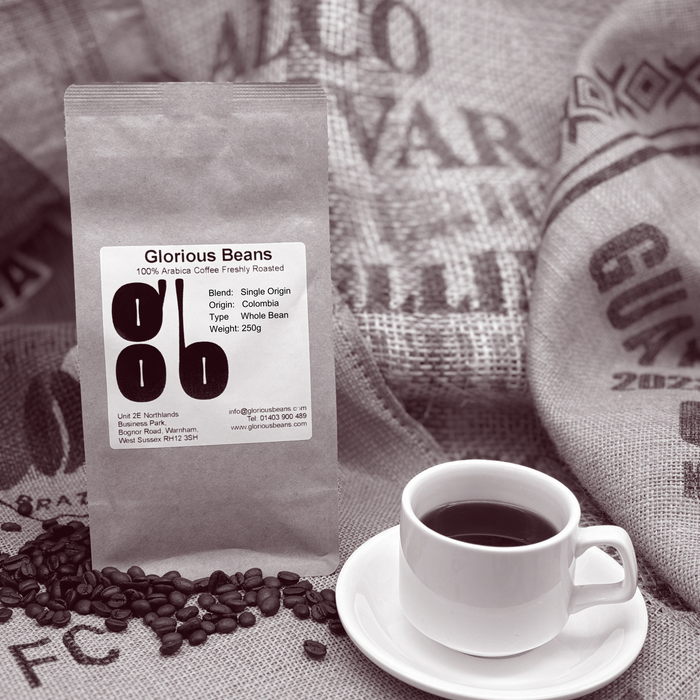Coffee Beans 101: Whatever You Need to Find Out About Coffee and Blended Coffee Beans
When it pertains to coffee, comprehending the subtleties of coffee and mixed beans can transform your day-to-day mug. You'll find the distinctive features of Arabica and Robusta beans, and how each effects taste and caffeine content. From the expanding procedure to roasting techniques, every action contributes in your coffee experience. So, what makes the best brew? Allow's check out the vital aspects that contribute to a remarkable cup of coffee.
Recognizing Coffee Beans: Kinds and Varieties
When diving right into the world of coffee, recognizing the types and selections of coffee beans is necessary for every fanatic. You'll largely run into 2 primary species: Arabica and Robusta. Arabica beans are recognized for their smooth, intricate tastes and lower high levels of caffeine material, making them a favorite amongst coffee connoisseurs. On the various other hand, Robusta beans load a strike with a more powerful, more bitter preference and greater high levels of caffeine degrees, frequently made use of in coffee blends.
Within these types, you'll locate different regional ranges, each bringing unique features. For example, Ethiopian Yirgacheffe supplies bright flower notes, while Colombian beans provide a healthy taste profile. As you check out, bear in mind to take note of handling approaches like washed or all-natural, as they can substantially affect the last preference. By acquainting yourself with these beans and their tastes, you'll elevate your coffee experience and make more informed selections in your brewing trip.
The Growing Process: From Seed to Bean
When you explore the trip of coffee, everything beginnings with seed choice strategies that establish the structure for top quality. From there, farming and harvesting play essential roles in guaranteeing the beans thrive. Ultimately, handling methods change those gathered cherries right into the coffee beans you love.
Seed Selection Techniques
Choosing the right seeds is crucial for producing high-quality coffee beans, as it lays the foundation for the whole growing process. You must start by selecting seeds from reliable sources that focus on quality and hereditary variety. Try to find ranges recognized to prosper in your specific climate and dirt problems. Pay focus to the seed's age and storage conditions, as fresh seeds often tend to sprout better. When feasible, select organic seeds to decrease direct exposure to harmful chemicals. Take into consideration the illness resistance of various ranges, as this can greatly impact your yield. Lastly, don't hesitate to speak with regional farmers or experts to gain understandings into the most effective seed options for your area. This knowledge will certainly enhance your coffee-growing experience.
Growing and Harvesting
As you nurture your coffee seeds into flourishing plants, recognizing the growing and harvesting procedure is vital for accomplishing the very best flavor and high quality. Start by planting your seeds in well-draining dirt, ideally in a shaded location to shield them from direct sunshine. As your plants expand, maintain constant dampness, and bear in mind their need for nutrients. Prune on a regular basis to promote air movement and healthy development.
Hand-picking is usually the finest technique to assure just the ripest cherries are picked. Timing is essential; harvesting as well late or also early can affect the taste account of your beans.

Handling Techniques Described
Once you have actually harvested your coffee cherries, the next vital step is processing them to change those vivid fruits right into the beans you'll brew. In the dry procedure, you spread out the cherries out in the sunlight to completely dry, enabling the fruit to ferment and pass on one-of-a-kind flavors to the beans. Comprehending these methods is vital to enjoying your coffee experience.
Roasting Strategies: Exactly How Taste Is Established
When it comes to toasting coffee beans, recognizing roast degrees is essential to revealing their special tastes. Each roasting method influences the aroma and improves the flavor development procedure, providing you a richer coffee experience. Let's check out exactly how these aspects come together to boost your everyday mixture.
Roast Levels Discussed
Roast levels play a crucial function fit the taste account of your coffee. You'll take pleasure in brilliant acidity and fruity notes when you choose a light roast. As you transfer to a medium roast, you'll notice an equilibrium of sweet taste and complexity, typically highlighting delicious chocolate or sugar tastes. Dark roasts, on the other hand, supply bold, smoky qualities with less acidity, making them durable and abundant. Each level arises from different roasting times and temperatures, affecting the beans' chemical composition. By understanding these levels, you can better pick a coffee that matches your preference choices. Experiment with different roasts to discover which one reverberates with you, boosting your general coffee experience and pleasure.
Effect On Scent
The roast level not only influences the preference of your coffee yet also substantially affects its aroma. When you select a light roast, you'll usually see bright, flower notes that can make your coffee smell fresh and lively. As the beans darken, the fragrance shifts; a medium roast brings out a lot more balanced, caramelized fragrances, while a dark roast tends to include strong, great smoky undertones. Each toasting strategy launches various unstable compounds, shaping how your coffee smells. In addition, the quality of the beans plays a vital duty; fresh baked coffee launches extra fragrant oils, improving that attracting scent. So, focus on the roast level-- it's key to revealing the full fragrant experience of your brew.
Taste Development Process
As you check out the flavor development procedure, you'll discover that toasting methods play a crucial role in forming the preference profile of your coffee. The toasting temperature and time directly affect the level of acidity, sweet taste, and resentment of the beans. Light roasts preserve more of the bean's initial flavors, highlighting floral and fruity notes.
Coffee vs. Blended Coffee: Trick Differences
Espresso and combined coffee each offer unique experiences that satisfy various preferences and preferences. Espresso is a focused coffee brewed by requiring warm water with finely-ground coffee beans, leading to an abundant, strong taste and a velvety layer of crema ahead. It's often enjoyed as a shot or utilized as a base for drinks like cappucinos and cappuccinos.
On the other hand, combined coffee incorporates various beans from various areas, producing a much more balanced flavor account. You'll typically discover blends that highlight acidity, sweetness, or body, making them functional for different brewing techniques. While coffee SOE concentrates on strength, combined coffee may supply a more comprehensive series of flavors that can change with each sip.
Ultimately, your selection in between espresso and combined coffee boils down to your individual preference. Whether you long for a leisurely mug or a quick jolt, both choices have something scrumptious to use.

Brewing Methods: Opening the Perfect Cup
When it concerns brewing coffee, locating the right approach can transform your experience and elevate your cup. Each developing method has its distinct beauty and can considerably impact your coffee's flavor and scent. Making use of a French press enables you to delight in a rich and robust brew, while a pour-over approach gives a clean, brilliant mug with distinct flavors.
If you favor coffee, buying a top quality device can aid you master the art of drawing shots. Conversely, for benefit, a single-serve shuck system offers speed without sacrificing preference.
Do not neglect concerning cold brew, which delivers a smooth, much less acidic coffee suitable for warm days. Experiment with different approaches to find what resonates with your palate.
Tasting Notes: Determining Flavor Profiles
Exactly how can you really value your coffee if you do not know what flavors to search for? Sampling notes are your overview to recognizing the complex globe of coffee. Pay interest to the initial tastes that hit your taste buds when you sip. You could identify fruity notes, like berry or citrus, or perhaps a nutty touch. As you remain to taste, observe just how the tastes progress-- this is called the "surface." Some coffees could leave a chocolatey or sugar aftertaste, while others might have an intense, clean coating.
Think about the body of the coffee, as well; is it light and ventilated or thick and syrupy? Don't neglect level of acidity; a bright acidity can add vigor, while a reduced acidity might give a smoother experience. By recognizing these taste profiles, you'll strengthen your link with each cup, making coffee tasting a fascinating journey of discovery.

Tips for Selecting and Keeping Coffee Beans
Picking and storing coffee beans effectively can greatly improve your developing experience. Begin by picking high-grade beans that match your preference. Seek quality; beans baked within the last 2 weeks are ideal. Check the roast date on the product packaging, and purchase from local shops or credible roasters.
When you have your beans, store them in an airtight container to avoid exposure to light, dampness, and air. A dark, awesome place functions best, so stay clear of keeping them in the refrigerator or fridge freezer, as this can introduce moisture. Only grind the quantity you require to preserve quality; entire beans keep flavor longer than pre-ground coffee.
Last but not least, attempt to utilize your beans within 2 to 4 weeks after opening for peak taste. Complying with these suggestions will ensure your coffee stays satisfying and savory, elevating your everyday brew to new heights.
Often Asked Inquiries
How Much Time Do Coffee Beans Keep Fresh After Roasting?
Coffee beans stay fresh for about two weeks after toasting - SOE. You should store them in an airtight container, away from light and dampness. Afterwards, their taste and scent begin to reduce significantly

Can I Mix Different Coffee Bean Varieties?
Absolutely, you can blend different coffee bean selections! Trying out with blends can boost tastes and create an unique taste account. Simply make sure to stabilize the staminas and qualities of each variety for the best results.
What Is the Ideal Grind Dimension for Espresso?
For coffee, you'll want a great work size, concerning the appearance of salt. This enables optimal removal, causing an abundant, tasty shot. Experiment a bit to find what suits your taste best!
How Does Altitude Affect Coffee Bean Taste?
Altitude impacts coffee bean flavor by affecting the growth rate and chemical composition. Higher elevations cause slower growth, which boosts level of acidity and intricacy, providing your coffee a unique and vivid taste you will not forget.
Exist Decaffeinated Versions of Coffee Beans?
Yes, there are decaffeinated versions of coffee beans. You can enjoy an abundant coffee taste without the high levels of caffeine kick. Just look for "decaf" blends at your regional cafe or specialty store.
Coffee Beans 101: Whatever You Need to Know About Espresso and Blended Coffee Beans.
When diving into the world of coffee, understanding the kinds and ranges of coffee beans is necessary for every lover.When it comes to roasting coffee beans, recognizing roast degrees is essential to exposing their one-of-a-kind flavors. Espresso is a focused coffee made by compeling hot water via finely-ground coffee beans, resulting in an abundant, strong flavor and a luscious layer of crema on top.On the other hand, mixed coffee integrates numerous beans from different regions, creating an extra well balanced flavor profile.
Comments on “Why SOE Single Origin Espresso Is Highly Rated Among Baristas”